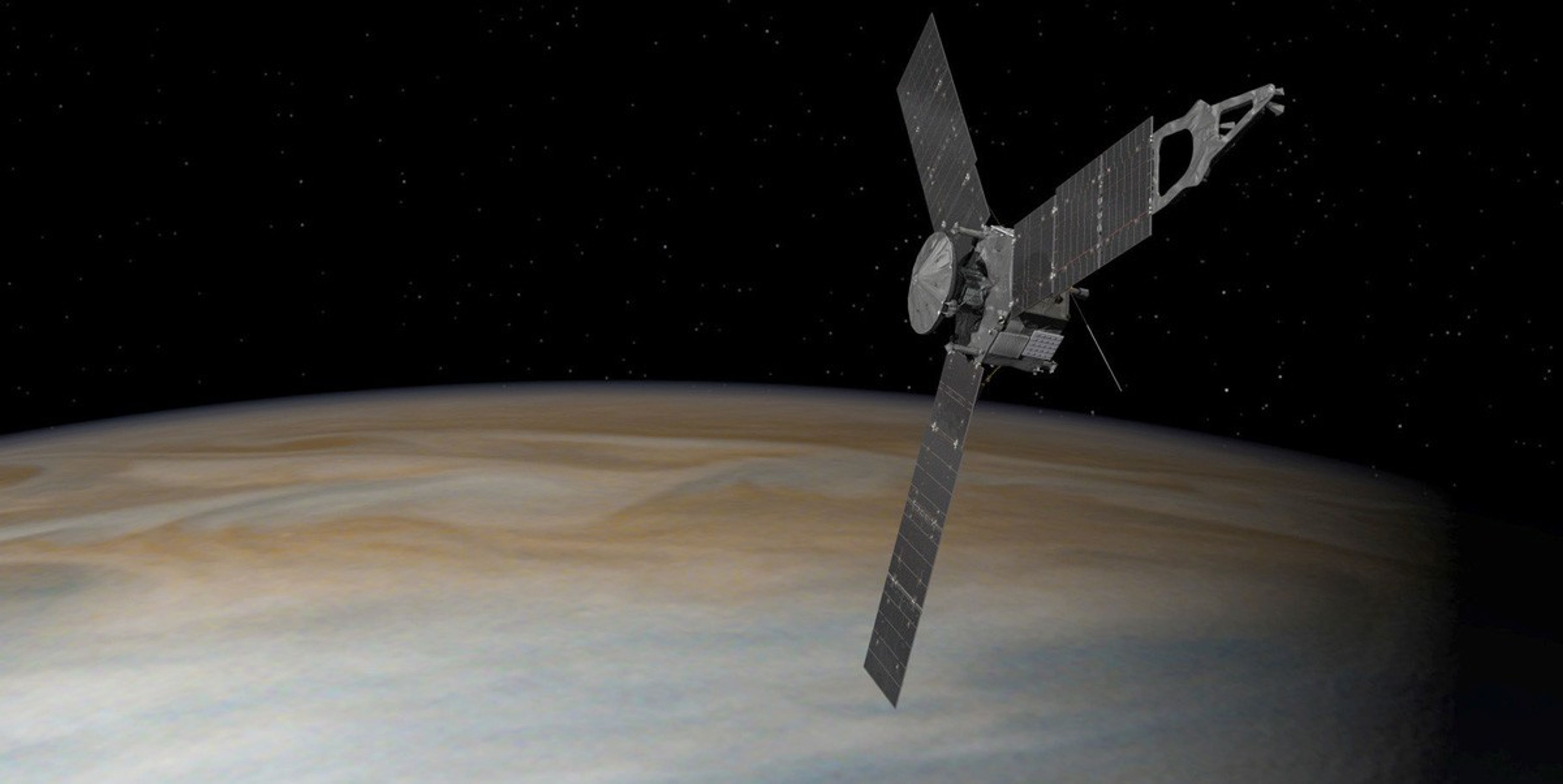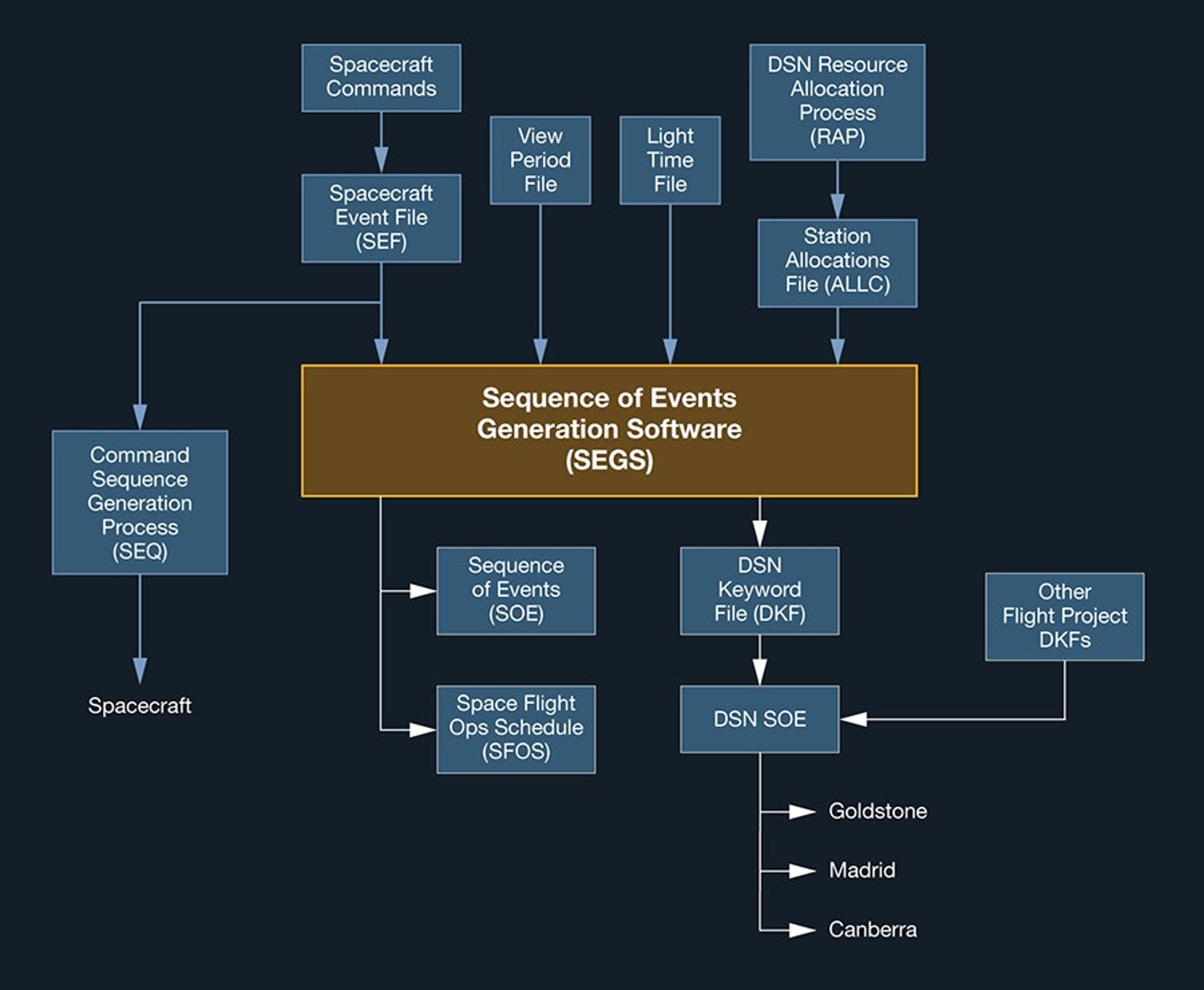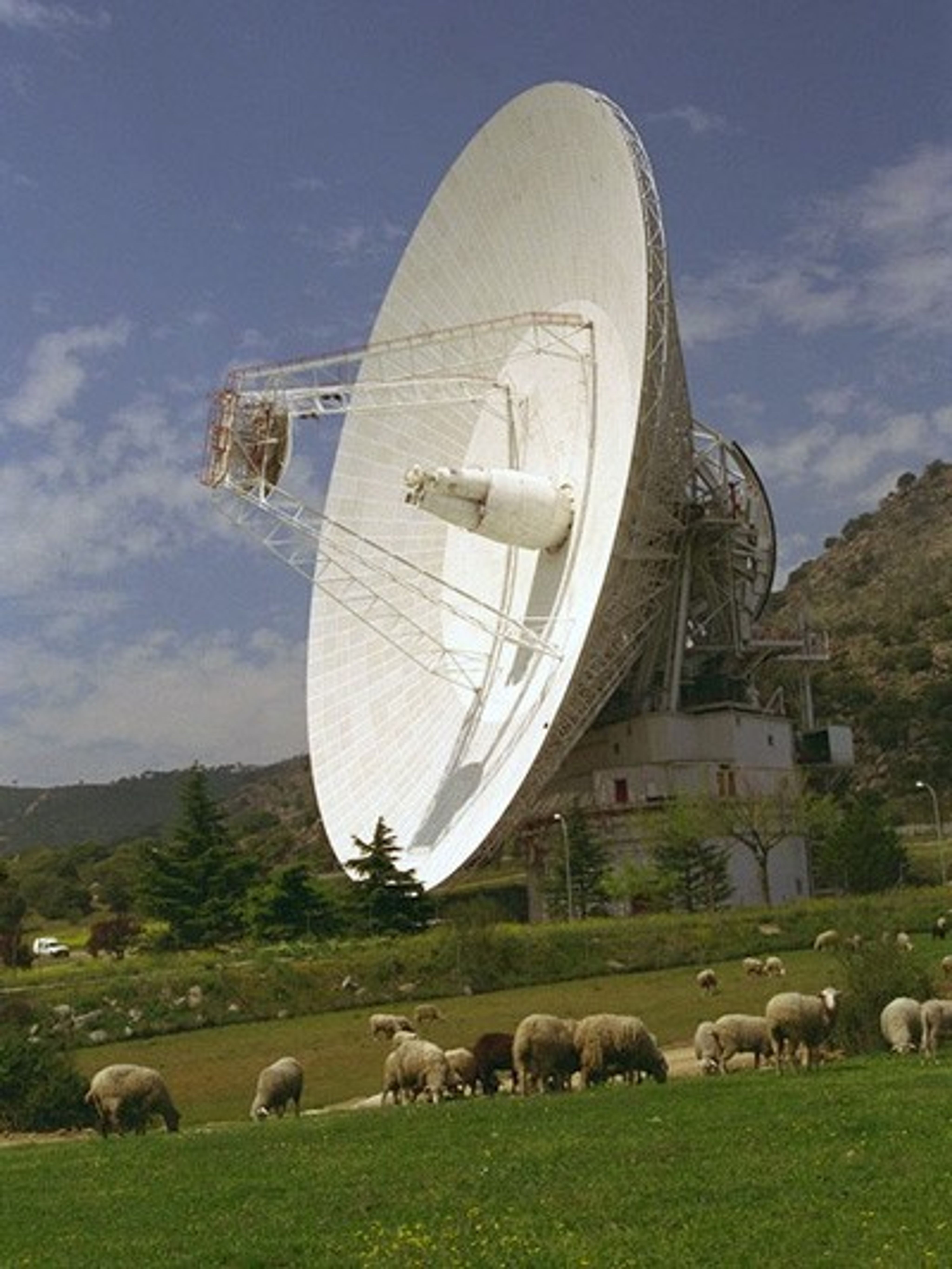Chapter 15: Cruise
Chapter Objectives
Upon completion of this chapter, you will be able to list the major factors involved in a mission's cruise phase, including spacecraft checkout and characterization, and preparation for encounter. You will be able to characterize typical daily flight operations.

Cruise phase is bounded by launch phase at the beginning and encounter phase at the end. It may be as short as a few months, or it may span years with the spacecraft looping the Sun to perform gravity-assist planetary flybys. It is a time during which ground system upgrades and tests may be conducted, and spacecraft flight software modifications are implemented and tested. Cruise operations for JPL missions are typically carried out from the Space Flight Operations Facility at JPL.
On Aug. 5, 2011, the Juno spacecraft was launched on a mission to Jupiter. It conducted a gravity-assist flyby of Earth on Oct. 9, 2013 before completing its five-year journey on July 5, 2016, when the spacecraft entered orbit around Jupiter. During its six-year primary mission, Juno will search for clues about Jupiter's composition and study its gravity and magnetic fields.
Spacecraft Checkout and Characterization
After launch, the spacecraft is commanded to configure for cruise. Appendages that might have been stowed in order to fit within the launch vehicle are deployed either fully or to intermediate cruise positions. Telemetry is analyzed to determine the health of the spacecraft, indicating how well it survived its launch. Any components that appear questionable might be put through tests specially designed and commanded in or near real time, and their actual state determined as closely as possible by subsequent telemetry analysis.
During the cruise period, additional command sequences are uplinked and loaded aboard for execution, to replace the command sequence exercised during launch. These take the spacecraft through its routine cruise operations, such as tracking Earth with its HGA and monitoring celestial references for attitude control. Flight team members begin to get the feel of their spacecraft in flight.
Commonly, unforeseen problems arise, and the onboard fault protection algorithms receive their inevitable tests; the spacecraft will, more likely than not, go into safing or contingency modes (as described in Chapter 11), and nominal cruise operations must be painstakingly recovered.
TCMs (Trajectory Correction Maneuvers), are executed to fine-tune the trajectory. As the spacecraft nears its target, or earlier during designated checkout periods, the science instruments are powered on, exercised and calibrated.
Real-time Commanding
Frequently, command sequences stored on the spacecraft during cruise or other phases must be augmented by commands sent and executed in or near real time, as new activities become desirable, or, less frequently, as mistakes are discovered in the on-board command sequence.
There are risks inherent in real-time commanding. It is possible to select the wrong command file for uplink, especially if an extensive set of files exists containing some similar or anagrammatic filenames. Also, it is possible that a command file built in haste may contain an error. Planned sequences of commands (generally just called "sequences") are typically less risky than real-time commands because they benefit from a long process of extensive debate and selection, testing and checking and simulation prior to uplink.
Some flight projects permit real-time commanding of a sort wherein command mnemonics are entered at the command system keyboard in real time and uplinked directly. Other projects do not permit this inherently high-risk operation because even a typographical error passing undetected might introduce a problem with the spacecraft or the mission.
These factors may limit the desirability of undertaking many activities by real-time commands, but the necessity, as well as the convenience, of at least some form of real-time commanding frequently prevails.
Typical Daily Operations
Usually, at least one person is on duty at the Flight Project's realtime mission support area at JPL or other location, during periods when the Deep Space Network (DSN) is tracking the spacecraft. This person, typically the mission controller, or "Ace," watches realtime data from the spacecraft and ground system, and responds to any anomalous indications via pre-planned responses. Anomaly response plans usually include getting in touch with appropriate subsystem experts in real time, no matter what time it is locally, to evaluate the situation and determine how best to proceed.
The Ace is a person on the Mission Control Team or Real-time Operations Team who is the single point of contact between the entire flight team, consisting of, for example, a Spacecraft Team, a Navigation Team, Science Teams, and other teams on the one hand, and teams external to the flight project such as DSN, Facilities Maintenance, multimission Data Systems Operations Team (DSOT), Ground Communications Facility (GCF), Advanced Multi-Mission Operations System (AMMOS), System Administrators (SAs), Network Administrators, and others, on the other hand.
"Ace" is not an acronym, despite attempts to make it one. It simply refers to one single point of contact for a project's real-time flight operations, and is not too inappropriately a pun for an expert pilot. Most Aces have experience with many different missions. It is possible for one Ace to be serving more than one flight project at a time.
The Ace executes commanding, manages the ground systems, insures the capture and delivery of telemetry, monitor, and tracking data, watches for alarm limit violations in telemetry, manages the alarm limits, evaluates data quality, performs limited real-time analyses to determine such things as maneuver effectiveness and spacecraft health to first order, and coordinates the activities of the DSN and other external teams in support of the flight project(s). Typically, a large portion of the Ace's interactions are with the Spacecraft Team, the DSN, and the DSOT. On the infrequent occasions when the Ace detects an anomaly and rules out any false indications, he or she proceeds to invoke and follow the anomaly response plan that has been approved by the flight project. That plan is then followed by appropriate flight team members until the anomaly is resolved, and nominal operations are restored.
Monitoring Spacecraft and Ground Events
In order to tell whether everything is proceeding nominally, an Ace needs an accurate list of expected events, to compare with spacecraft events as they are observed in real time. For example, the spacecraft's downlink signal may change or disappear. Was it planned, or is this an anomaly?
Such a list is also required for the purpose of directing DSN station activity, and for planning command uplinks and other real-time operations. For example, if we uplink a command at 0200 UTC, will the spacecraft actually receive it one-way light-time later, or will the spacecraft be off Earthpoint or behind a planet at that time?
That list is called the sequence of events, SOE. It contains a list of spacecraft events being commanded from the onboard sequence, and DSN ground events such as the beginning and end of tracking periods, transmitter operations, and one-way light times.
Compiling an SOE and related products begins with a list of the commands that will be uplinked to the spacecraft's sequencing memory, and that will execute over a period of typically a week or a month or more into the future. The list of commands, sorted into time-order, comes from engineers responsible for spacecraft subsystems, scientists responsible for their instruments' operations, and from others. Times for the events' execution are included with the commands. The team responsible for generating the command sequence then creates a spacecraft event file (SEF). This file goes on as an input to the remainder of the sequence generation process for eventual uplink to the spacecraft.
A copy of the SEF also goes to the sequence of events generator software, SEGS, where commands are adjusted for light time, and are merged with DSN station schedule information and events. Station viewperiod files and light time files are typically provided by the navigation team. One of SEGS output products is the DSN keyword file (DKF). This file is provided to the DSN, who then combines it with similar listings from other projects to create an SOE for each particular station. SEGS outputs the SOE in tabular form, and also arranges most of the same information into a high-level graphics product, the space flight operations schedule, SFOS. Users can view each of these products, or create hardcopy, using SEGS viewing and editing software. The illustration below shows activities typical for the generation of SOE products.


Tracking the Spacecraft in Flight
DSN tracking requirements and schedules have been negotiated months or even years in advance of launch. Now the spacecraft is in flight. Near the time when the spacecraft will be rising in the sky due to Earth's rotation, its assigned DSN tracking activity begins.
Precal: During the period allotted for "precal" activities, the Network Monitor and Control (NMC) operator sits down at her or his console in the Signal Processing Center (SPC) of one the DSN's three Deep Space Communications Complexes (DSCC). The operator will be controlling and monitoring the assigned antenna, called a Deep Space Station (DSS), as well as an assigned set of computers that control its pointing, tracking, commanding, receiving, telemetry processing, ground communications, and other functions.
This string of equipment from the antenna to the project people at JPL is called a "connection," referring to the two-way communications link between the spacecraft and the project. The NMC operator in this role is called the "Connection Controller." Prior to the Connection Controller's arrival, the Complex Manager (a higher-level NMC function) operator will have assigned, via directives sent out to the station components over a local area network (LAN), applicable equipment to become part of the connection.
At about this time, a JPL Communications technician establishes a voice link between the Connection Controller and the Ace. The Ace offers a pre-pass briefing to the Connection Controller, highlighting the important activities for the upcoming pass, and any changes in the latest documentation.
Now the Connection Controller begins sending more directives over the SPC LAN to configure each of the link components specifically for the upcoming support. Predict sets containing uplink and downlink frequencies, Doppler bias ramp rates, pointing angles and bit rates, command modulation levels, and hundreds of other parameters, are all sent to the link components. Any problems are identified and corrected as the Connection Controller and the Ace communicate as needed during the "precal."
Near the end of the precal period, the Connection Controller checks the DSS area via closed circuit TV, makes a warning announcement over its outdoor loudspeakers, and the DSS antenna swings to point precisely to the spacecraft's apparent location above the eastern horizon.
BOT: Beginning of Track (BOT) is declared. At the prearranged time, typically ten minutes after BOT, the DSS's transmitter comes on, and red rotating beacons on the antenna illuminate as a warning of the microwave power present. Upon locking the receivers, telemetry, and tracking equipment to the spacecraft's signal, the link is established. This marks the Beginning of Track (BOT) and Acquisition of Signal (AOS).
The Ace interacts with the Connection Controller as needed during the course of the track to be sure the flight project's objectives are met. Depending on the nature of the spacecraft's activities, there may be Loss of Signal (LOS) temporarily when the spacecraft turns away to maneuver, or if it goes into occultation behind a planet. This LOS would presumably be followed by another AOS when the maneuver or occultation is complete. During the day, the DSS antenna moves slowly to follow, or track, the spacecraft as the Earth rotates.
EOT: Near the end of the Connection Controller's shift, the DSS is pointing lower on the western horizon. At the same time, if continuous tracking is scheduled, another Connection Controller inside the SPC of another DSCC a third of the way around the world, is in touch with the Ace, conducting a precal as the same spacecraft is rising in the east from the new station's point of view. To accomplish an uplink transfer, the setting DSS's transmitter is turned off precisely two seconds after the rising DSS's transmitter comes on. Scheduled End of Track (EOT) arrives, and the Connection Controller at the setting DSS begins postcal activities, idling the link components and returning control of them to the Complex Manager operator. After a de-briefing with the Ace, the Ace releases the station, so it can begin preparing for its next scheduled activity.
Preparation for Encounter
Command loads uplinked to the spacecraft are valid for varying lengths of time. So-called quiescent periods such as the lengthy cruises between planets require relatively few activities, and a command load may be valid for several weeks or even months. By comparison, during the closest-approach part of a flyby encounter of a prime target body, a very long and complex load may execute in only a matter of hours.
Prior to the Voyagers' encounters, the spacecraft was generally sent a command sequence that took it through activities simulating the activities of encounter. Nowadays, this kind of rehearsal is largely accomplished with ground-based simulation, using simulated data broadcast to users. Changes in data rate and format, and spacecraft maneuvers, are designed to put the flight team and ground systems through their paces during a realistic simulation, in order to provide some practice for readiness, to shake down the systems and procedures, and to try to uncover flaws or areas for improvement. In a few critical cases, the actual encounter command load, slightly modified so that some activities (such as rocket firings) are skipped, may be actually executed aboard the spacecraft as a final test. This was the case with Cassini's Saturn Orbit Insertion critical sequence, and also with its Huygens Mission Relay critical sequence.
Instrument calibrations are undertaken prior to encounter, and again afterwards, to be sure that experiments are being carried out in a scientifically controlled fashion.





